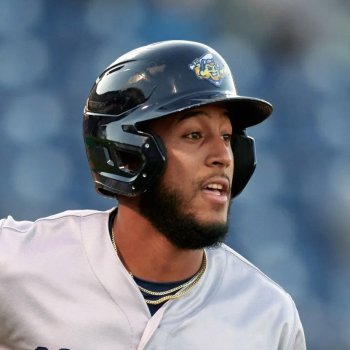
Twins Video
Looking at their ranks across baseball, it’s hard to nitpick anything in the lineup that’s a glaring weakness. This group is second in wOBA, ISO, SLG, and OPS. They are top five in wRC+ and top in in both fWAR and OBP. Scoring an average of 5.63 runs per game, they are producing at the fourth best clip in the sport. All of this has taken place without Miguel Sano and withhaving played a handful of National League games which excluded slugger Nelson Cruz.
Now, back to Buck. The former top prospect posted a 3.5 fWAR in 2017 thanks in large part to a ridiculous end of the season. 2018 was a lost year due to injury, but 2019 has started out on a trajectory that has the Georgia native’s arrow pointing way up. He’s already compiled 0.7 fWAR and owns a .283/.338/.517 slash line. Leading the majors in doubles with 12, Buxton has consistently put himself into scoring position from the bottom of the lineup.
Operating under the assumption that Baldelli wants to move Byron up, we need to look at the order to figure out where the best fit presents itself. In my opinion, there are three different spots he fits: first, second, or sixth. Leadoff hitters of yesteryear were cut from the cloth that is Byron’s most obvious asset, speed. He can get on and immediately wreak havoc upon opposing pitchers. The two hole is typically one of your best hitters, maximizing the opportunity to score that leadoff batter. Sixth would be a combination of a run production spot, as well as a secondary leadoff type for the bottom half of the order.
Making the argument for Buxton to hit leadoff isn’t one considered in a vacuum. The decision must come down to whether you’re better suited with him there than Max Kepler, and if Kepler produces as much value in the six hole. Through 69 plate appearances Kepler has turned in a .242/.319/.435 slash line. His 10.1% walk rate is down just over a percent from 2018, but the heightened hard-hit rate should be inducing a better BABIP than the current result as time goes on. It’s an incredibly small sample at this point, but the inputs don’t jump off the page as problematic. Baldelli needs more than a .319 OBP from his leadoff man, but time for it to trend upwards is still there.
I think we can probably rule out the two hole completely. Jorge Polanco is currently hitting in that spot and is among the best hitters in all of baseball at this point. He’s not going to continue posting a 1.083 OPS forever but expecting that bat to play at a high clip has always been the blueprint for the converted second basemen. Allowing Polanco to both drive in and produce his own offense makes him an ideal fit for this spot in the lineup.
Although not the massive jump in the order some may like to see, sixth is where Buxton could have the greatest impact. When going at his best, the profile looks the part of a run-producing slugger more than that of an on-base machine. Byron has thrived by attacking earlier in counts and avoiding an opportunity for the pitcher to get ahead. His 6.5% career walk rate doesn’t fit the mold of a leadoff hitter, and while the doubles are plentiful now, some of those balls will leave the park as the weather warms up.
Looking at the bats employed by the Twins, and how Buxton’s impact is felt once he’s on the bases (again: he’s fast), there becomes an opportunity cost to factor in. Should Buxton reach and steal ahead of guys like Nelson Cruz, Eddie Rosario, or eventually Miguel Sano, he can score from first base on a large portion of their base hits. Conversely, batting ahead of the bottom half immediately vaults the importance of grabbing an extra base and generating scoring opportunities. In the lower half of the lineup, Byron could legitimately threaten 50 stolen bases. If he’s hitting ahead of the thumpers, there’s less desire for him to be running and therefore an under-utilization of arguably his greatest asset.
To generate the level of production Buxton is currently clipping along at he obviously needs to have made strides across the board. That much is evident when looking at his batted ball profile. He’s got a career best 37.8% hard hit rate (nearly 10% north of his career average) and has pushed his fly ball rate over 50% for the first time. As far as contact goes, things have stayed relatively status quo. Byron is still swinging through the same rate of pitches and putting bat to ball as often as he always has. It’s the quality that has allowed results to vastly improve.
At the end of the day there’s no denying that this is the Byron Buxton we’ve all (and likely the man himself as well) been waiting for. The presence of a hitter of this caliber anywhere in a big-league lineup is going to be a significant asset. As time goes on, it will be on the Twins baseball staff to decide where his production is maximized. With a couple of options at their disposal, we’ll need to wait and see what route is chosen. This change could be coming sooner rather than later however, and the center fielder forcing his club’s hand is a problem this organization has long awaited. It’s time to hit ‘em off with somethin’ proper, get Buck in here!
MORE FROM TWINS DAILY
— Latest Twins coverage from our writers
— Recent Twins discussion in our forums
— Follow Twins Daily via Twitter, Facebook or email
— Become a Twins Daily Caretaker






Recommended Comments
Join the conversation
You can post now and register later. If you have an account, sign in now to post with your account.
Note: Your post will require moderator approval before it will be visible.